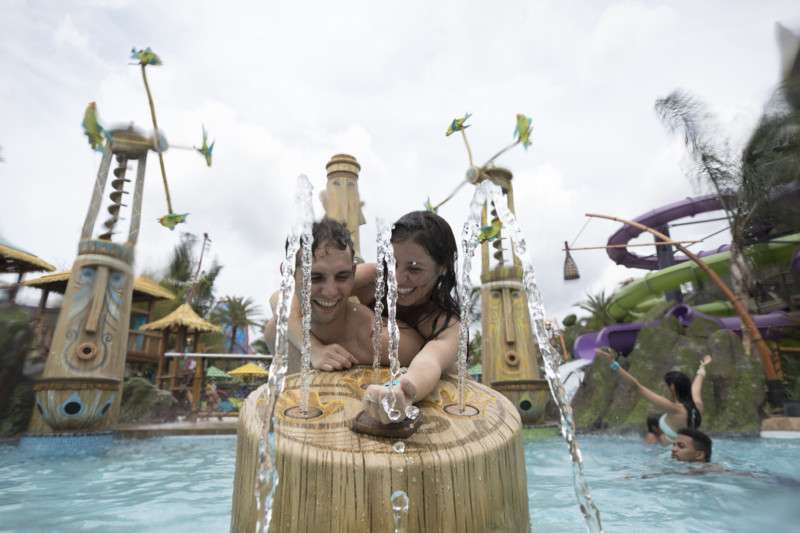by Freddy Martin
ABOVE: Guests at Universal’s Volcano Bay use RFID enabled TapuTapu wristbands to activate fountains and effects. Photo courtesy of Universal Orlando
A veritable tide of versatile technologies has triggered a deluge of creative and operational advancements in waterparks and wet attractions, offering operators and designers new options for improving guest experience and safety. Based on conversations with leaders in the field, we identified ten wet technologies currently making waves in themed entertainment.
As we dive in, we keep in mind that the motive is to help people connect in deep and meaningful ways at visitor attractions. As one of our experts, Denise Chapman Weston, Director of Imagination and Inventor, Infinite Kingdoms, said, “The park should become this place where you can play and engage in ways you never could do at home. That’s the real joy of using technology, not the technology itself.”
1.RFID wearables
RFID chips embedded in wearable, waterproof devices offer freedom, security and convenience, enabling guests in bathing suits to spend money on food, beverages and souvenirs without a visit to the locker. The benefits for both operators and guests can be significant.
“We’re seeing companies provide products that interface with all the ticketing and payment companies, in all the turnstiles and all the lockers,” said Michael Turner, Vice President of Global Business Development at The Producers Group. “They’re able to track guest movements and ridership, providing insight into park throughputs and visitor flow.”
Universal’s Volcano Bay waterpark opened with their TapuTapu™ system, which offers virtual queuing to all slides in the park. This allows guests to spend more of their vacation relaxing and playing than waiting in line. Volcano Bay was honored with a TEA Thea Award in 2019.
As RFID technology matures, parks are exploring greater opportunities for guest interactivity, tracking, and management. “By having real-time access to more accurate data and guest profile information,” said Nick Neuman, CEO at Water Technology Inc., “we can better customize water ride and attractions experiences for different ages and experience levels. As a waterpark designer, this creates an entirely new dimension to explore within water attraction development.”
2. Regenerative media filtration
The sustainability of water-based attractions is rooted in their ability to store, clean, and reuse water. Eco-friendly technologies are necessary to maximize water usage while creating a clean and healthy environment for guests.
Waterparks have high public visibility and are therefore vulnerable to criticism about their water usage. But, says Turner, “Compared to other industries that use a lot of water, waterparks are actually positioned to conserve water rather than waste it.”
Regenerative Media Filtration (RMF) is not new technology, but it is considered the industry standard for the removal of suspended particles of dirt, oil, and other contamination in highbather-load water attractions. RMF filters use materials derived from volcanic rock which is far more efficient and effective for removing contaminants. A single pass through RMF filters captures the smallest particles, including many disease-causing microorganisms. The efficiency and effectiveness of RMF filtration results in significant reduction in wastewater, chemical treatment, and energy used for heating and pumping.
3. UV disinfection
While chlorine treatment remains the most effective method for sterilizing water, it is a harsh chemical and hazardous if not properly handled. “With UV sterilization that danger is virtually removed,” said Turner. Water passes under a spectrum of UV wavelengths killing microbes and bacteria and neutralizing the harmful chemical by-products of chlorine use. Even the chlorineresistant germ Cryptosporidium can’t survive UV treatment. UV disinfection does not completely eliminate the need for chlorine treatment, but it does significantly reduce its use.
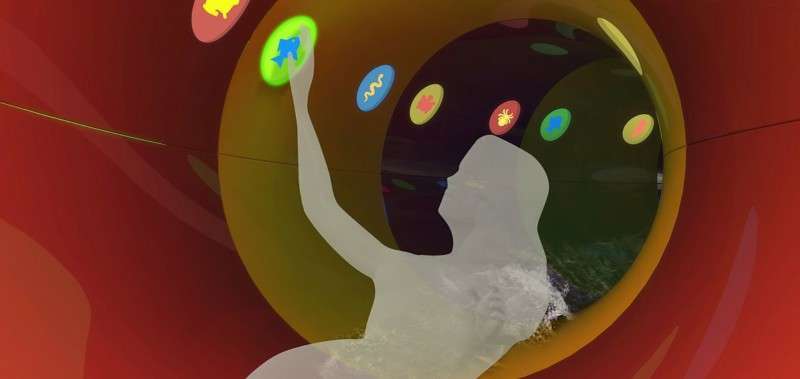
4. Gamification
“Five years ago, a slide was a slide,” said Michael Turner. “Guests want something different now. Gamified slides make it really exciting for the guests to ride over and over again.”
Ride makers are now including gaming technology in slides to create a sense of competition, camaraderie, and excitement, encouraging repeat ridership and repeat visitation. In some, like Slide’N Touch from Polin Waterparks, riders tap LED light panels to earn points and achievements as they speed through tubes.
In others, such as Slideboarding (from WhiteWater, honored in 2018 with a TEA Thea Award for technology) controls are built into the ride vehicle. Guests gain points by tapping the buttons according to cues in the slide. Integration with visitor management technologies encourages riders to keep record of their high scores from past visits and build upon their success in the future.
Others are integrating VR and AR technologies into slide experiences. Guests can splash down into virtual worlds while wearing waterproof VR headsets. The motion of the slide combined with timed visuals creates a unique sensation, all while targeting achievements inside the virtual environment.
Submersible VR headsets are also kicking off a wave of visually enhanced snorkeling experiences and underwater simulators that are pushing the limits of waterpark gaming.
5. LIM propulsion
It wasn’t too long ago that waterslides depended on gravity for their momentum, and inevitably headed down. Engineers began adding strong water jets, speed belts, and magnetic propulsion to add ups to the downs. Today, we have Linear Induction Motor (LIM) technology taking water coasters up, up, up!
“LIM propulsion really gives the sensation that you’re defying gravity, which is what everybody wants,” said Chris Lange, Creative Director and Consultant on various international LBE projects including Europa-Park’s new water theme park, Rulantica [featured in this issue of InPark]. “I think that technology will keep getting smoother and smoother as it develops.”
Linear Induction Motors produce a magnetic field between the motor and a metal plate built into the raft to propel riders up and over hills. LIM technology is touted as giving operators exceptional control over vehicle position and speed. A prominent example is at Universal’s Volcano Bay: riders launch uphill seven thrilling times in Krakatau Aqua Coaster, a custom LIM water coaster provided by ProSlide, based on its “Hydromagnetic Rocket.”
6. Electromagnetic control
Electromagnetic control is also turning the tide for higher capacity boat rides, with a strong recent example being the ride control system used in the Pirates of the Caribbean attraction at Shanghai Disneyland (another recent TEA Thea Award recipient). Boat rides have generally depended on water jets to propel boats through narrow channels; electromagnetic control technology, however, allows for programmable control of each boat’s position, speed, and orientation. Show effects, dialog, and music cues can be timed precisely to a boat’s position, and control over boat spacing makes it possible to isolate boats within scenes giving riders a secluded experience.
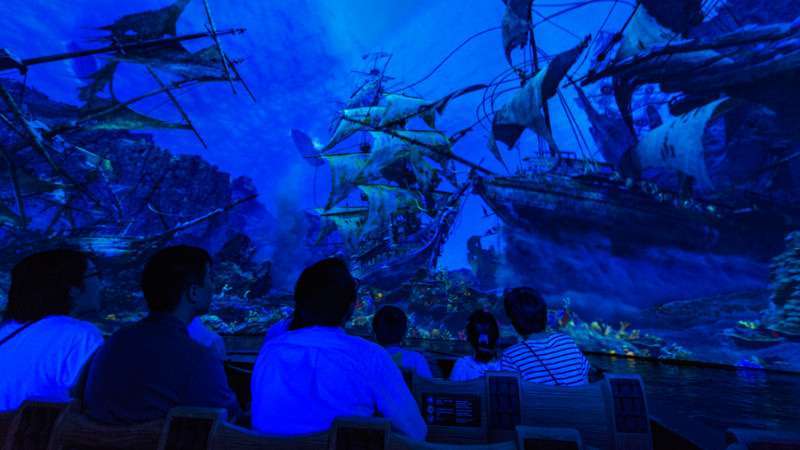
“What really excites me is feeling the boat react to the action of the story, perfectly timed to the music,” said Lange. “You speed up and slow down perfectly and that really is like magic.” According to Lange, Mack Rides “is developing and prototyping a completely different system for a boat ride that gives you even more flexibility and precise control over the boat; I think we will see them being used much more in the future.”
7. Remote lighting
As AV technologies advance, park visitors increasingly expect more sophisticated sensory experiences. For waterparks, however, electrical equipment such as lights, lasers, and projectors introduce a safety challenge when used in proximity to water.
“One thing I learned while I was working on aquariums at Sea Life for Merlin, was that ‘water will find a way,’” said Lange. “It’s crazy how water is always a little unpredictable. So using high voltage equipment in water, underwater, next to water, is really tricky.”
Water attraction designers use technologies such as fiberoptic illuminators or laser projectors to safely bring technology effects closer to the water. Fiberoptic cable can port bright and colorful lighting effects right up to the water’s edge while the illuminator unit, the only electrical component of the system, can be operated at a safe distance. Laser projectors are reliable, accurate, and bright enough to be installed at great distances, far from where they can cause or be subject to damage.
“There are some really fantastic technology groups progressing the development of different systems to help achieve this next level of storytelling experience with water attractions,” said Neuman. “Introducing complex storytelling and theming within water attractions has created massive opportunities to make each trip to the waterpark unique, be it through music, sound effects, projection, 3D mapping, or special effects.”
8. RGB LED lighting
RGB LEDs continue to revolutionize the ways in which people illuminate shows and environments. The color range and flexibility of LED systems gives waterpark operators unlimited control over underwater lighting, for both show effects and safety. For safety reasons, it’s important to have good lighting in a waterpark’s wave pool, and to have high visibility for lifeguards. But, “nobody wants a bright, shining wave tank, especially in an indoor environment where it reflects off the ceiling,” says Lange. “Now we can play with the underwater lights to fit a certain mood or theme or we can adjust it according to the weather or time of day, or the situation.”
The increased availability and decreasing costs of LEDs and fountain technology also provide better opportunities for smaller operators to create compelling water shows and effects to dazzle and delight their visitors.
9. New waves in wave technology
Competition in wave pool technology drives innovation – thanks to the popularity of surfing – and sends ripples through the waterpark industry. The resulting designs and prototypes are as diverse and daring as the adventurous athletes who test them. One or more of these could one day be adopted at a waterpark near you!
• Kelly Slater’s Surf Ranch (California) prototype is a 2,000-foot-long pool with underwater hydrofoils propelled by a freight train-sized vehicle cruising down a track. The six-foot waves it generates are hyper-smooth, glassy barrels.
• The Cove by Wavegarden (Spain) is a diamond-shaped wave pool that delivers up to 1,000 programmable waves per hour. The ability to model size and shape allows athletes training opportunities unavailable in the ocean.
• PerfectSwell (Texas) uses air pressure to generate ocean-like swells for a natural surfing experience. The waves aren’t as cleanly defined as others, but their rough texture is more like the ocean to help inlanders prep for the real deal.
• Surf Lakes (Australia) is a 1400-ton, buoy-shaped plunger that is like something out of Waterworld. Its massive body plunges down and up in the water generating concentric circles that break like real waves for dozens of surfers at a time.
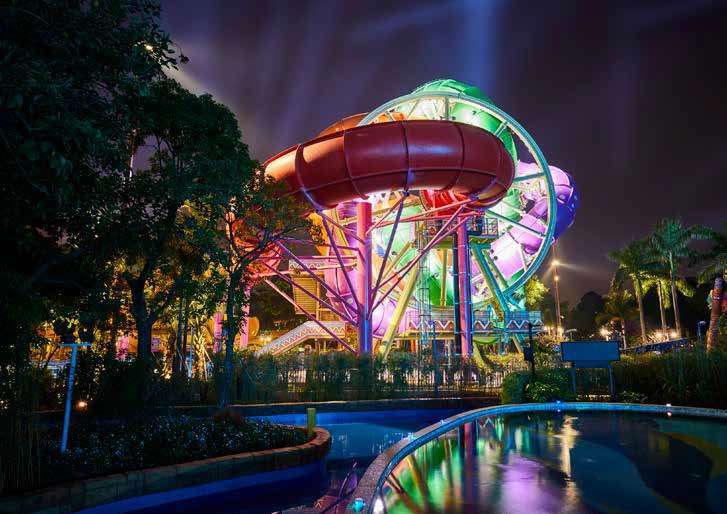
10. SlideWheel
A list of revolutionary water attraction technologies wouldn’t be complete without the SlideWheel, the world’s first rotating water slide, honored with the IAAPA Impact Award & Brass Ring for Best New Product, the WWA Leading Edge Award, and a TEA Thea Award in 2019. The outrageous design is part Ferris wheel and part waterslide, and creates a visual spectacle by day and night in addition to the thrill of the ride.
Like all new technologies, it had to be built and tested as proof of concept. “To be honest, when the prototype was built and we did the first tests, nobody knew if it would really work,” said Rainer Maelzer, formerly of weigand.maelzer, the developer of the attraction. “We tested it with dummies. We had cameras in there with them and we said, ‘Hey, it could work!’ It wasn’t until it was completely built that we could really know.”
In June 2019, Canadian firm WhiteWater gained exclusive licensing rights to SlideWheel. from weigand.maelzer (now weigand.waterrides) [ See feature on WhiteWater in this issue]. The first SlideWheel opened in Guangzhou, China at Chimelong in 2018, and the second will open soon at Aquapark Reda, in Poland. • •

Freddy Martin ([email protected]) is a writer, storyteller, and independent consultant. He began his theme park voyage as a skipper on the Jungle Cruise at Disneyland. Freddy cohosts the Themed Attraction Podcast with Mel McGowan of Storyland Studios, and is a regular contributor to InPark as well as ThemedAttraction. com. He also blogs at FreddyMartin.net.
Tomorrow’s wet techs
3D printing: rethinking materials and construction
Aggressive chlorine use and the gases it releases into the air are notoriously corrosive. Parks and suppliers are exploring a new world of creative possibilities that can help counter this challenge by rethinking the materials used for construction, theming, and attractions. And the increased use of 3D printing technology has opened up new options for engineering components that are long-lasting and corrosion-resistant – and may well lead to more comprehensive, large-scale applications that change the way facilities are constructed.
Said Christopher Foster, Vice President of Sales and Marketing at COST of Wisconsin, “We recommend materials for this environment – especially indoor facilities – that minimize maintenance costs and maintain good aesthetic appearance over long periods of time.”
“Mechanical effects and animated figures don’t need to be made from marine steel anymore,” said Lange. “3D printed mechanical parts made out of plastic or other new materials will make it possible to achieve cool new effects that support the storyline without using steel that rusts away.”
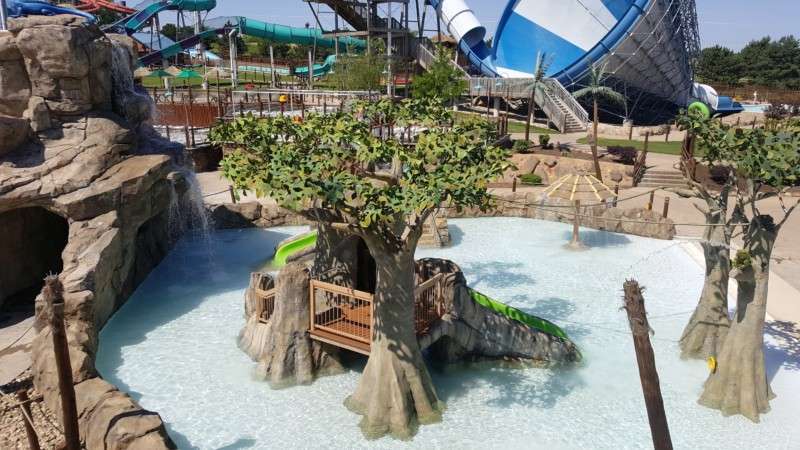
Energy conservation
Weston poses an interesting question that her firm has embraced as a challenge. “But what if we generated energy on our own? What if the attraction actually powered itself?”
Many parks strive to be part of the energy solution by integrating solar, wind, and hydro into their operations. The kinetic nature of waterpark environments can inspire parks to introduce energy generating technology in creative ways.
“We are working toward harnessing play as a ‘natural resource’ for powering some of our attractions,” said Weston. “Our latest inventions, which we’re calling ‘DNA,’ part of the Impact Attractions Series, are these unusual new play experiences for waterparks that are not only zero-net energy consumers, but actually give back to the grid.”
RFID alternatives
Some innovators are looking at RFID alternatives for visitor management. The new frontier may be to ditch the wearables and make use of image or object tracking. “In waterparks, we commonly think that wearable, embedded technology is the way to go,” said Weston. “But we’re banking on a future where we won’t need that. By simply showing up and registering for the experience, guests will have access to all of the benefits the technology has to offer. We will have the ability to virtually recognize specific guests on sight and to curate really cool, interactive experiences for them with more trackability and less friction.”
Social media solutions
One challenge waterparks face with technology is the selfie paradox. When guests stow their phones in lockers, they separate themselves from social media for the day and cut off one of today’s most valuable park promotion opportunities – the selfie. Neuman said, “There is a significant relevance for owners and operators to be able to tap into these networks for promotion and advertising. Waterpark users desire to capture dynamic memories and share them among their friends and families in real time. As designers we are looking to capitalize on that desire by providing platforms for it to be memorialized online.” •


